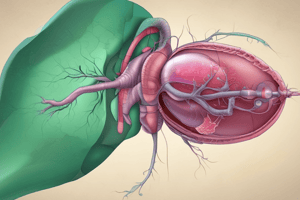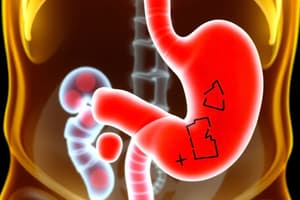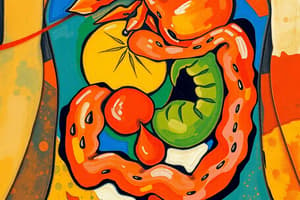Podcast
Questions and Answers
Which of the following best describes the pathophysiology of gallbladder disease?
Which of the following best describes the pathophysiology of gallbladder disease?
- Increased peristalsis of the small intestine
- Autoimmune attack on the liver
- Increased gastric acid production
- Obstruction of bile flow in biliary ducts (correct)
What are contributing factors to gallstone formation? (Select all that apply)
What are contributing factors to gallstone formation? (Select all that apply)
- Chronic inflammation (correct)
- Abnormal bile composition (correct)
- High calcium intake
- Biliary stasis (correct)
- Rapid gastric emptying
A patient is diagnosed with acute cholecystitis. This is most commonly caused by:
A patient is diagnosed with acute cholecystitis. This is most commonly caused by:
- Excessive alcohol intake
- Blockage of the cystic duct by gallstones (correct)
- Viral infection of the gallbladder
- Liver cirrhosis
What is the most common demographic affected by cholelithiasis?
What is the most common demographic affected by cholelithiasis?
Which factor is least likely to contribute to cholelithiasis?
Which factor is least likely to contribute to cholelithiasis?
A nurse assesses a patient with suspected cholecystitis. Which finding is expected?
A nurse assesses a patient with suspected cholecystitis. Which finding is expected?
Which symptoms are common in a patient with cholelithiasis? (Select all that apply)
Which symptoms are common in a patient with cholelithiasis? (Select all that apply)
A client with cholecystitis asks why their stool is gray. What is the best response?
A client with cholecystitis asks why their stool is gray. What is the best response?
A nurse palpates rebound tenderness in the RUQ. What does this most likely indicate?
A nurse palpates rebound tenderness in the RUQ. What does this most likely indicate?
A client presents with fever, RUQ pain, and jaundice. What is the priority concern?
A client presents with fever, RUQ pain, and jaundice. What is the priority concern?
Which lab result is most consistent with biliary obstruction?
Which lab result is most consistent with biliary obstruction?
The nurse is reviewing diagnostic results. Which test confirms gallstones?
The nurse is reviewing diagnostic results. Which test confirms gallstones?
Which of the following are potential complications of untreated cholecystitis? (Select all that apply)
Which of the following are potential complications of untreated cholecystitis? (Select all that apply)
Which diagnostic result should the nurse report immediately?
Which diagnostic result should the nurse report immediately?
A nurse notes fever and elevated WBC in a client with cholecystitis. What is the priority action?
A nurse notes fever and elevated WBC in a client with cholecystitis. What is the priority action?
Which medication is commonly used to dissolve small cholesterol gallstones?
Which medication is commonly used to dissolve small cholesterol gallstones?
A client with gallbladder disease is prescribed meperidine (Demerol) for pain. The nurse knows this medication is preferred over morphine because:
A client with gallbladder disease is prescribed meperidine (Demerol) for pain. The nurse knows this medication is preferred over morphine because:
Which medication would the nurse question for a client with cholecystitis?
Which medication would the nurse question for a client with cholecystitis?
Which of the following medications would be used to manage nausea in a client with gallbladder disease?
Which of the following medications would be used to manage nausea in a client with gallbladder disease?
What is the purpose of administering antibiotics to a patient with acute cholecystitis? (Select all that apply)
What is the purpose of administering antibiotics to a patient with acute cholecystitis? (Select all that apply)
What nonpharmacologic interventions are appropriate for managing cholecystitis symptoms? (Select all that apply)
What nonpharmacologic interventions are appropriate for managing cholecystitis symptoms? (Select all that apply)
A client asks why they need to reduce fat in their diet after gallbladder removal. The best response is:
A client asks why they need to reduce fat in their diet after gallbladder removal. The best response is:
The nurse teaches a client with cholelithiasis about lifestyle changes. Which statement indicates understanding?
The nurse teaches a client with cholelithiasis about lifestyle changes. Which statement indicates understanding?
Nonpharmacologic pain relief measures post-laparoscopic cholecystectomy include:
Nonpharmacologic pain relief measures post-laparoscopic cholecystectomy include:
Which of the following are appropriate nursing interventions for managing hyperlipidemia in gallbladder disease? (Select all that apply)
Which of the following are appropriate nursing interventions for managing hyperlipidemia in gallbladder disease? (Select all that apply)
Which statement about laparoscopic cholecystectomy is correct?
Which statement about laparoscopic cholecystectomy is correct?
During pre-op teaching, the nurse explains that laparoscopic surgery involves:
During pre-op teaching, the nurse explains that laparoscopic surgery involves:
What is a major advantage of laparoscopic over open cholecystectomy?
What is a major advantage of laparoscopic over open cholecystectomy?
Intraoperatively, the provider converts to open cholecystectomy. The nurse explains this may be due to:
Intraoperatively, the provider converts to open cholecystectomy. The nurse explains this may be due to:
A client asks why they are receiving general anesthesia for a laparoscopic cholecystectomy. The best response is:
A client asks why they are receiving general anesthesia for a laparoscopic cholecystectomy. The best response is:
Which of the following is an expected finding after laparoscopic cholecystectomy?
Which of the following is an expected finding after laparoscopic cholecystectomy?
A client is recovering post-laparoscopic cholecystectomy. Which instruction should the nurse include in discharge teaching?
A client is recovering post-laparoscopic cholecystectomy. Which instruction should the nurse include in discharge teaching?
Which teaching point should be included regarding incision care? (Select all that apply)
Which teaching point should be included regarding incision care? (Select all that apply)
A nurse is teaching a patient to use the incentive spirometer. Which instructions are correct? (Select all that apply)
A nurse is teaching a patient to use the incentive spirometer. Which instructions are correct? (Select all that apply)
Which is the best nursing intervention to prevent respiratory complications post-op?
Which is the best nursing intervention to prevent respiratory complications post-op?
A client reports nausea after surgery. Which is the priority nursing action?
A client reports nausea after surgery. Which is the priority nursing action?
What signs should prompt the nurse to suspect a post-op complication? (Select all that apply)
What signs should prompt the nurse to suspect a post-op complication? (Select all that apply)
A client post-cholecystectomy states, “I’m scared to move—it might hurt more.” What’s the best nursing response?
A client post-cholecystectomy states, “I’m scared to move—it might hurt more.” What’s the best nursing response?
What is the priority assessment immediately after a laparoscopic cholecystectomy?
What is the priority assessment immediately after a laparoscopic cholecystectomy?
The nurse is teaching a client post-cholecystectomy about diet. Which statement indicates understanding?
The nurse is teaching a client post-cholecystectomy about diet. Which statement indicates understanding?
Which client outcome indicates effective post-op teaching?
Which client outcome indicates effective post-op teaching?
What should the nurse monitor for to detect post-op bleeding? (Select all that apply)
What should the nurse monitor for to detect post-op bleeding? (Select all that apply)
A patient is ready for discharge. Which teaching point is correct?
A patient is ready for discharge. Which teaching point is correct?
The nurse evaluates a post-op patient who reports no bowel movement for 3 days. What is the best nursing action?
The nurse evaluates a post-op patient who reports no bowel movement for 3 days. What is the best nursing action?
Which lifestyle changes should the nurse teach post-cholecystectomy? (Select all that apply)
Which lifestyle changes should the nurse teach post-cholecystectomy? (Select all that apply)
Flashcards
Pathophysiology of gallbladder disease
Pathophysiology of gallbladder disease
Altered or obstructed bile flow through the hepatic, cystic, or common bile ducts.
Contributing factors to gallstone formation
Contributing factors to gallstone formation
Abnormal bile composition, biliary stasis, and chronic inflammation promote it.
Most common cause of acute cholecystitis
Most common cause of acute cholecystitis
Blockage of the cystic duct by gallstones.
Most common demographic affected by cholelithiasis
Most common demographic affected by cholelithiasis
Signup and view all the flashcards
Factor least likely to contribute to cholelithiasis?
Factor least likely to contribute to cholelithiasis?
Signup and view all the flashcards
Expected finding in cholecystitis
Expected finding in cholecystitis
Signup and view all the flashcards
Common symptoms in cholelithiasis
Common symptoms in cholelithiasis
Signup and view all the flashcards
Why is stool gray with cholecystitis?
Why is stool gray with cholecystitis?
Signup and view all the flashcards
Indication of RUQ rebound tenderness
Indication of RUQ rebound tenderness
Signup and view all the flashcards
Priority concern with fever, RUQ pain, and jaundice
Priority concern with fever, RUQ pain, and jaundice
Signup and view all the flashcards
Lab result consistent with biliary obstruction
Lab result consistent with biliary obstruction
Signup and view all the flashcards
Test that confirms gallstones
Test that confirms gallstones
Signup and view all the flashcards
Potential complications of untreated cholecystitis
Potential complications of untreated cholecystitis
Signup and view all the flashcards
Diagnostic result to report immediately
Diagnostic result to report immediately
Signup and view all the flashcards
Priority action with fever and elevated WBC
Priority action with fever and elevated WBC
Signup and view all the flashcards
Medication to dissolve small cholesterol gallstones
Medication to dissolve small cholesterol gallstones
Signup and view all the flashcards
Why meperidine is preferred over morphine
Why meperidine is preferred over morphine
Signup and view all the flashcards
Medication to question for cholecystitis
Medication to question for cholecystitis
Signup and view all the flashcards
Medication for managing nausea
Medication for managing nausea
Signup and view all the flashcards
Purpose of antibiotics for acute cholecystitis
Purpose of antibiotics for acute cholecystitis
Signup and view all the flashcards
Study Notes
Pathophysiology of Gallbladder Disease
- Gallbladder disease is usually caused by obstructed bile flow in the hepatic, cystic, or common bile ducts.
Contributing Factors to Gallstone Formation
- Abnormal bile composition, biliary stasis, and chronic inflammation all contribute to gallstone formation.
- High calcium intake and rapid gastric emptying are not considered risk factors for gallstone formation.
Acute Cholecystitis Cause
- Blockage of the cystic duct by gallstones most commonly causes acute cholecystitis.
- Gallstone obstruction of the cystic duct leads to inflammation (cholecystitis).
Demographics Affected by Cholelithiasis
- Women over 40, especially those with high-fat diets or obesity, are most commonly affected by gallstones.
Factors Least Likely to Contribute to Cholelithiasis
- Low cholesterol levels are not likely to contribute to gallstone formation
- High cholesterol levels do contribute to gallstone formation.
Expected Findings in Suspected Cholecystitis
- Severe right upper quadrant pain is expected with cholecystitis
- The pain may radiate to the back or shoulder.
Common Symptoms in Patients with Cholelithiasis
- Jaundice, gray-colored stool, and nausea and vomiting are common symptoms.
- Bradycardia and hyperactivity are unrelated to cholelithiasis.
Cause of Gray Stool in Cholecystitis
- Bile obstruction prevents normal pigment from reaching the intestines, resulting in gray stools.
Indication of Rebound Tenderness in RUQ
- Rebound tenderness in the RUQ is a classic sign of gallbladder inflammation.
Priority Concern with Fever, RUQ Pain, and Jaundice
- These symptoms comprise Charcot's triad.
- Charcot's triad (pain, jaundice, fever) points to cholangitis, a medical emergency.
Lab Result Consistent with Biliary Obstruction
- Elevated liver enzymes (AST, ALT, ALP) are consistent with biliary obstruction.
Test to Confirm Gallstones
- An ultrasound of the abdomen is the most common and effective method for detecting gallstones.
Potential Complications of Untreated Cholecystitis
- Untreated cholecystitis can lead to gallbladder rupture, peritonitis, pancreatitis, and liver damage.
- Diabetes mellitus is not directly caused by gallbladder issues.
Diagnostic Result to Report Immediately
- Elevated bilirubin suggests obstructed bile flow and possible hepatic involvement.
Priority Action with Fever and Elevated WBC in Cholecystitis
- Fever and leukocytosis may indicate infection.
- Notify the provider; this requires urgent evaluation.
Medication to Dissolve Small Cholesterol Gallstones
- Ursodiol (Actigall) helps dissolve cholesterol-based gallstones by reducing cholesterol saturation in bile.
Preferred Pain Medication for Gallbladder Disease
- Meperidine (Demerol) causes less spasm of the sphincter of Oddi
- Morphine is avoided because it may cause spasm of the sphincter of Oddi, worsening biliary colic.
Medication Used to Manage Nausea in Gallbladder Disease
- Ondansetron (Zofran)
- It is a 5-HT3 antagonist used for controlling nausea and vomiting.
Purpose of Antibiotics for Acute Cholecystitis
- Antibiotics treat infection, reduce inflammation, and prevent complications like abscesses.
Nonpharmacologic Interventions for Cholecystitis Symptoms
- A low-fat diet reduces biliary workload.
- Ambulation and heating pads help relieve discomfort.
Reason for Reducing Fat After Gallbladder Removal
- The gallbladder stores and concentrates bile; without it, fat digestion is less efficient.
Lifestyle Changes Indicating Understanding of Cholelithiasis Teaching
- Switching to a low-fat, low-carb diet helps prevent further complications or recurrence.
Nonpharmacologic Pain Relief After Laparoscopic Cholecystectomy
- Ambulation helps reabsorb the gas used during laparoscopic surgery and reduces pain.
Nursing Interventions for Managing Hyperlipidemia in Gallbladder Disease
- Encourage a low-fat diet, recommend daily exercise, promote weight loss if overweight, and educate about cholesterol-lowering medications.
Correct Statement About Laparoscopic Cholecystectomy
- Laparoscopic removal is the standard surgical procedure for symptomatic gallstones.
Explanation of Laparoscopic Surgery
- Multiple small incisions are made for instrument access during laparoscopic surgery.
Advantage of Laparoscopic Over Open Cholecystectomy
- Laparoscopy involves smaller incisions, leading to quicker recovery and less discomfort.
Reason for Converting to Open Cholecystectomy Intraoperatively
- Sometimes an open procedure is needed if anatomy is unclear or complications arise.
Reason for General Anesthesia for Laparoscopic Cholecystectomy
- General anesthesia is needed for optimal surgical conditions and patient safety.
Expected Finding After Laparoscopic Cholecystectomy
- Shoulder pain is common due to residual gas used during the laparoscopic procedure.
Discharge Teaching After Laparoscopic Cholecystectomy
- Early ambulation promotes gas reabsorption and prevents complications like DVT or pneumonia.
Teaching Points for Incision Care
- Proper incision care includes cleanliness, observation for infection, and dressing management.
- Soaking or powders are contraindicated.
Correct Instructions for Using an Incentive Spirometer
- Inhale slowly and deeply, use every hour while awake, hold breath for 3–5 seconds after inhaling, and cough after using it.
- Frequent use of the IS helps prevent atelectasis.
- Proper use involves deep inhalation, breath holding, and coughing to clear secretions.
Nursing Intervention to Prevent Respiratory Complications Post-Op
- Incentive spirometer use expands alveoli and prevents pneumonia and atelectasis.
Priority Nursing Action for Post-Op Nausea
- Post-op nausea may be due to decreased GI motility.
- Always assess for bowel sounds and distention before intervening.
Signs Prompting Suspicion of Post-Op Complication
- Fever, jaundice, purulent drainage, and urinary retention are signs of complications.
- Mild shoulder pain is expected post-lap-chole.
Best Nursing Response to Fear of Movement Post-Cholecystectomy
- Encouraging ambulation prevents complications and promotes healing.
Priority Assessment After Laparoscopic Cholecystectomy
- Post-anesthesia, airway and breathing are the priority.
Patient Statement Indicating Understanding of Post-Cholecystectomy Diet
- A low-fat diet helps prevent GI upset after gallbladder removal.
Client Outcome Indicating Effective Post-Op Teaching
- Early ambulation is a positive indicator of engagement in recovery.
Monitoring for Post-Op Bleeding
- Signs of internal bleeding include tachycardia, hypotension, pallor, and distention.
- Elevated WBC suggests infection, not bleeding.
Correct Teaching Point at Discharge
- Heavy lifting is restricted to prevent strain on incisions and abdomen.
- Avoid lifting over 10 lbs for at least a week.
Best Nursing Action for Post-Op Patient with No Bowel Movement
- Post-op ileus is common; walking and fluids help restore bowel motility.
Lifestyle Changes to Teach Post-Cholecystectomy
- Promoting an active lifestyle, low-fat diet, and healthy weight helps prevent GI issues and promotes healing.
- Fiber is encouraged.
Studying That Suits You
Use AI to generate personalized quizzes and flashcards to suit your learning preferences.




